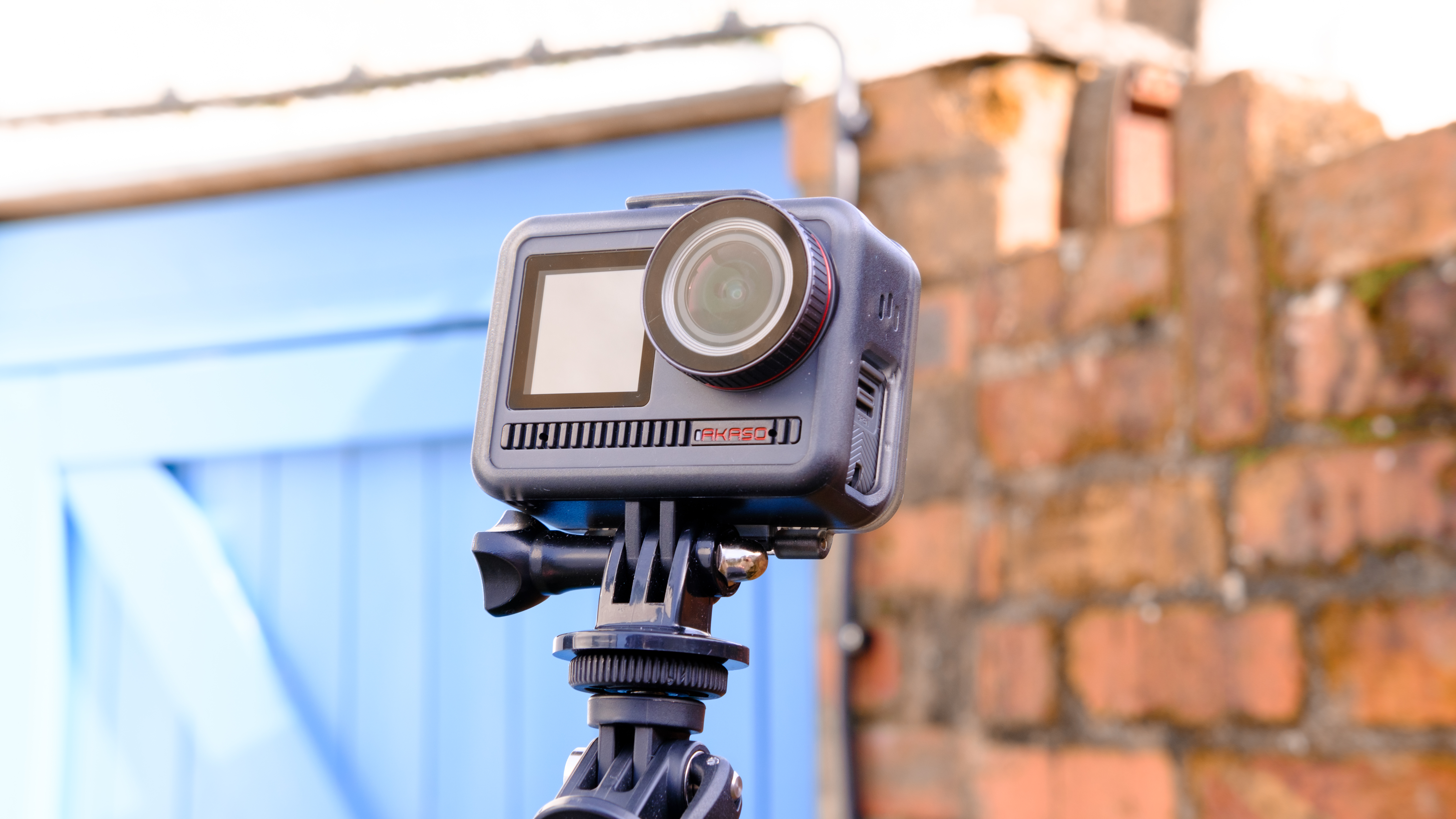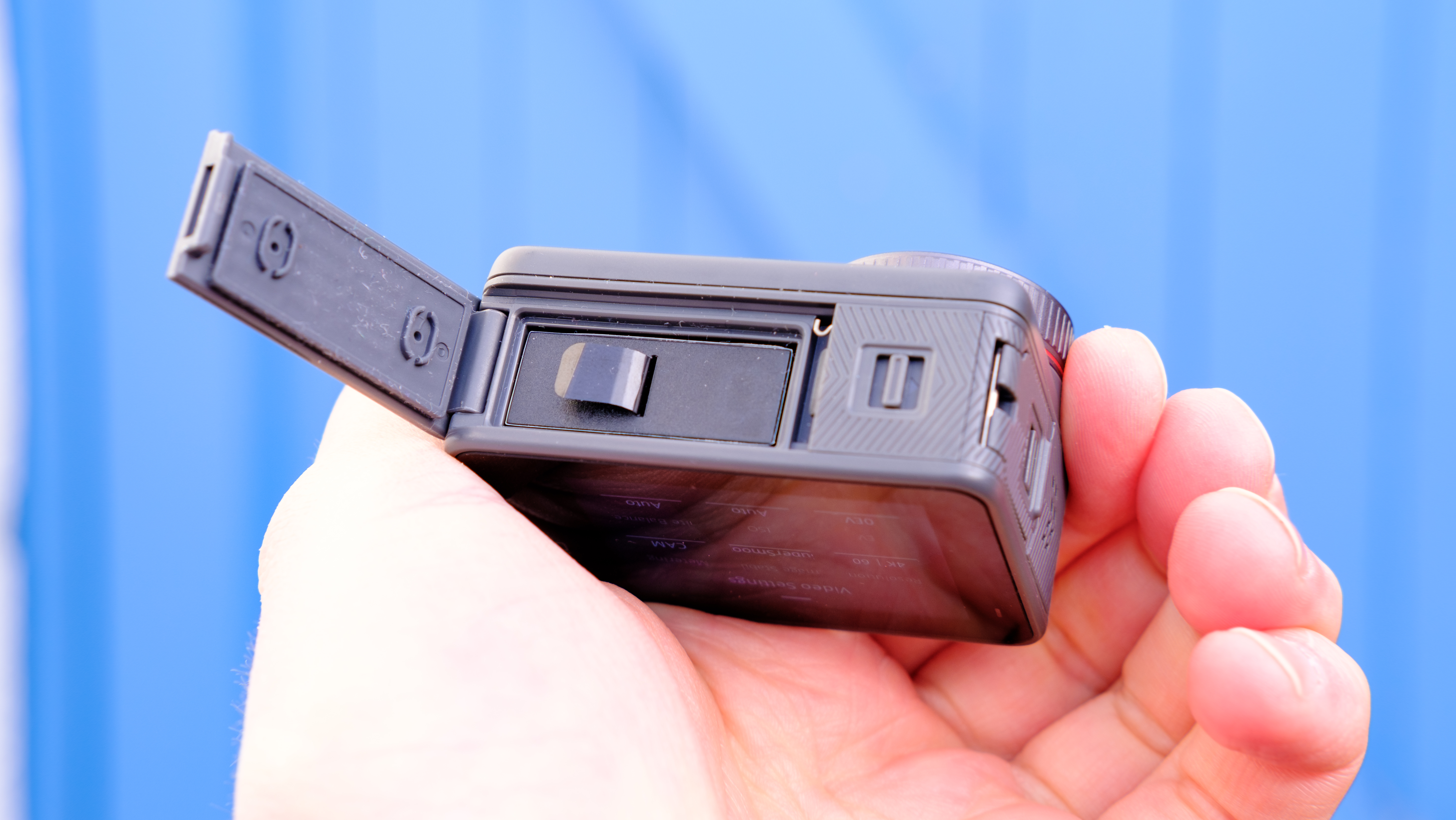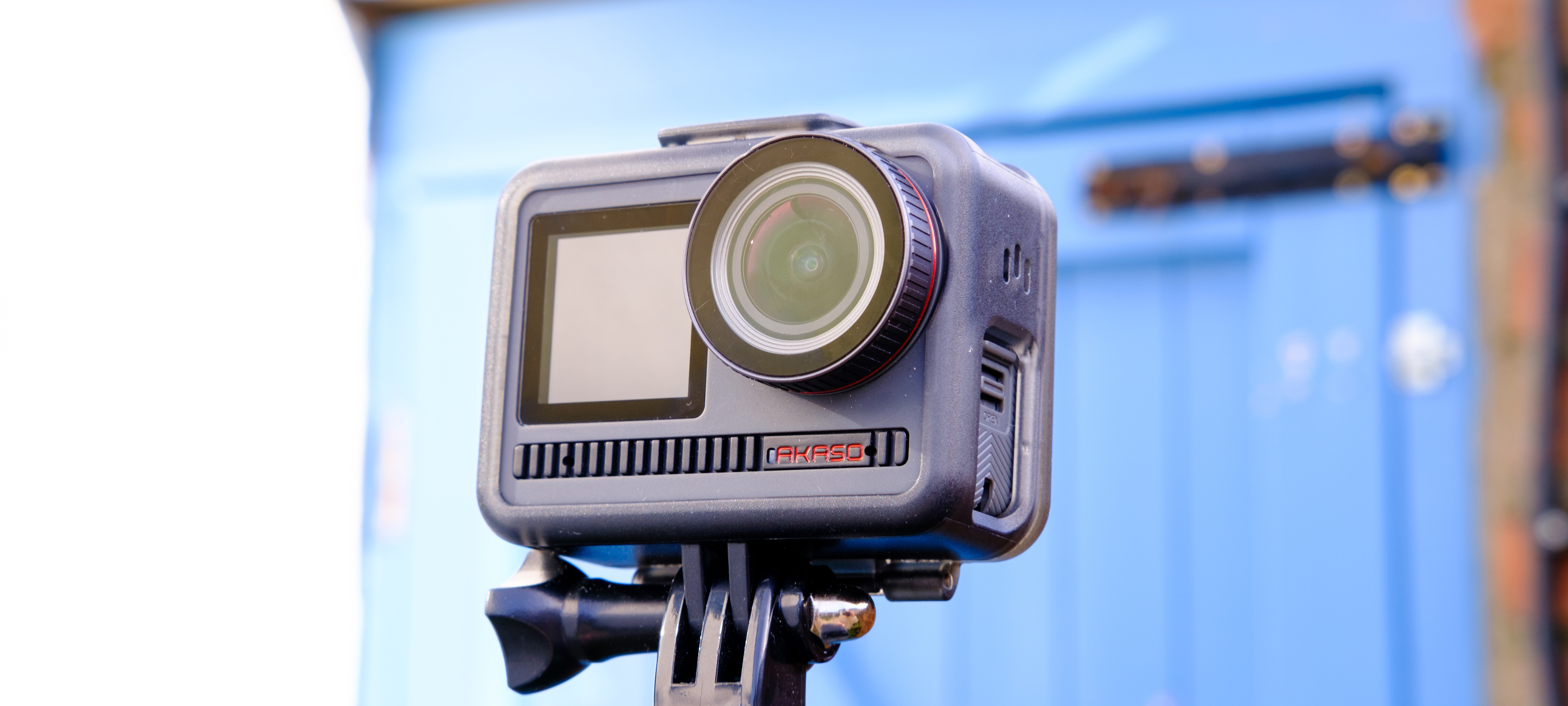Tom's Guide Verdict
The Akaso Brave 8 has a few redeeming features, but doesn’t do enough to justify its price. It is let down by poor image stabilization and internal audio, cheap construction materials and a lack of quality control.
Pros
- +
Shoots 4K/60p
- +
Decent image quality
- +
Range of slow mo options
Cons
- -
Overpriced for features
- -
Low quality construction
- -
Terrible image stabilization
- -
Poor internal audio
- -
Lack of battery QC
Why you can trust Tom's Guide
Starting price: $289
Max video resolution: 4K/60 fps
Slow motion: 2.7K/120 fps
Rear screen: 2-inch LCD touch screen
Front screen: 1.3-inch LCD screen
Size: 2.4 x 1.4 x 1.8 inches
Weight: 4 ounces
Water resistance: 33ft (10M)
Battery: 1550 mAh
The Akaso Brave 8 is the flagship camera from Akaso, a challenger brand in the action camera industry that seeks to provide high quality features at a lower price point than rival flagship cameras from GoPro, Insta360 and DJI.
The Brave 8 packs the best tech Akaso offers, featuring a ½-inch CMOS sensor, 4K/60p recording and image stabilization. On paper, at least, this could be a viable option for anyone not willing to splash out a fortune on one of the latest and best action cameras. However, the Akaso Brave 8 isn’t significantly cheaper than older (but still fantastic) cameras from premium competitors, meaning it has a lot to prove.
Unfortunately, while it has a few redeeming features, this action camera does not do enough to justify its price. To find out more, read on for our full Akaso Brave 8 review.
Akaso Brave 8 review: Price & availability
The Akaso Brave 8 costs $289 / £239 in standalone form and is available on Amazon. There are numerous bundles available for more money, including mounting options for different types of footage, including motorcycling, cycling and vlogging.
This is much cheaper than current flagship cameras from rivals like the GoPro Hero12 Black ($399), DJI Osmo Action 4 ($399) and Insta360 Ace Pro ($449). But the Brave 8 isn’t in the same league as those products.
Akaso’s website compares the Brave 8 with the GoPro Hero9 Black, whose specs it most closely aligns with. This is a little misleading though, as their site lists the Hero9 Black at its original retail price of around $350. You won’t be spending anywhere near that amount on the Hero9 Black these days (if you can find one new still). However, GoPro is still selling the fantastic GoPro Hero10 Black for $249 / £249, which makes the Brave 8 look vastly overpriced, as you’ll see from its performance below.
Akaso Brave 8 review: Design & controls
The Akaso Brave 8 looks like a classic action camera. It’s small, measuring just 2.4 x 1.4 x 1.8 inches (63 x 36.5 x 45mm) and weighing just over 4 ounces (115g) with a battery installed.
Get instant access to breaking news, the hottest reviews, great deals and helpful tips.

There’s a large front lens with a removable lens guard, a front screen for vlogging and a larger rear touch screen display — the touch screen is relatively bright and responds well to inputs, although switching between screens is fiddly.

The Brave 8 is rated as waterproof to 33 feet, which puts it on a par with the Hero10 Black and today’s flagships (except the Osmo Action 4, rated at 60 feet).
The camera body is wrapped partly in gray grippy rubber, which feels nice to the touch and gives an aura of ruggedness. Ports and hatches are made of very cheap plastic, though. Overall, build quality doesn’t feel bad, but is nowhere near as good as you’ll get with a Hero10 Black.

Connectivity-wise, the Brave 8 features a single USB-C port for hooking up accessories.
The Brave 8’s menu system is a little convoluted, but starts to make sense once you’re using it. Generally, the UI is nowhere near as streamlined as premium rivals.
Akaso Brave 8 review: Image stabilization
Akaso calls the Brave 8’s image stabilization system “Supersmooth,” which is about as ill-fitting a name as they could’ve come up with. The motorcycle video below shows just how jumpy footage gets, even with the maximum stabilization enabled.
If you’re engaging in less-bumpy pursuits — maybe driving footage — it may be passable. Anything moderately bumpy, though, such as cycling, motorcyling or running, and the IS really isn’t up to scratch, resulting in unusable footage if YouTube or social media is where you’d like to upload. In the low light video footage below, you can see that footage is jumpy when panning, even standing still (although those clips were taken with the stabilization off).
Invest instead in the Hero10 Black, and you’ll benefit from GoPro’s HyperSmooth 4.0 IS system. It won’t perform as well as the latest HyperSmooth 6.0 in the Hero12 Black or the IS system found in the Insta360 Ace Pro, but you’ll still get much better results than with the Akaso.
Akaso Brave 8 review: Video performance
The Akaso Brave 8’s image quality is one of its redeeming features. Bumpiness aside, 4K footage looks really nice, while the wide-angle optics don’t cause horrendous warping. There are several digital zoom modes, but these significantly affect image quality, so your best bet is to stay at the lens’ widest field of view.
Obviously, it’s nice to have 4K/60p, although at this price that should really be a given. The Brave 8 also features modes for timelapses and hyperlapses, and offers a decent range of slow motion formats: 120fps at 2.7K, 180fps at 1440p and 200fps at 1080p.
I found the Brave 8’s exposure metering to be pretty good. I tested the camera in bright winter sunlight and changing lighting conditions, which can be tricky, but the Brave 8 managed to keep an even exposure throughout, maintaining nice high shadows without blowing out the sky or brighter parts of the image. The Brave 8 also relayed accurate and flattering colors, capturing the cold atmosphere of the winter’s day but rendering the sky a deep, vivid blue.
Low light performance is nothing special. As you can see in the test video above, the image is quite dark, although this means that highlights remain better exposed, mitigating blow outs. Dimly lit areas are reasonably well exposed and image noise is far from destructive.
Overall, then, image performance is decent, but for less money the GoPro Hero10 Black shoots stellar video at up to 5.3K/60p without all the caveats in other departments.
Akaso Brave 8 review: Audio performance
The Akaso Brave 8’s internal microphone is poor. It isn’t the worst I’ve seen during my time testing action cameras (see our SJCAM SJ20 review for more on that), but it isn’t great. Wind noise is a particular problem at high speed, resulting in heavy amounts of distortion. Tellingly, there’s a button to turn the microphone off permanently positioned on-screen before you press the record button. You’ll want to use that in high wind or at speed, or invest in an external microphone.

Unfortunately, Akaso offers no mounting options for mics, meaning any microphone you hook up is left dangling. This is a good reason to go for a DJI (which offers wireless direct connection using the DJI Mic 2), Insta360 (which offers cold shoe brackets) or GoPro (which offers an official mic mod kit).
Akaso Brave 8 review: Smartphone app
The Akaso Go app pairs your smartphone with the Brave 8. The pairing process was relatively easy, but only once you realize that you need to tap the Wi-Fi icon on the camera itself before it’ll be detected by the app.
While it has nothing on Insta360’s class-leading app, I was pleasantly surprised by Akaso Go. It’s simple, but provides basic features like controlling the camera remotely, transferring videos from the camera and applying some basic edits including splitting and trimming, applying filters and adjusting exposure. Personally, I like to edit my footage on a computer using the best video editing software, but if you don’t have the budget for something like Adobe Premiere Pro, or the time to get to grips with free software like DaVinci Resolve, the basic tools on the app will at least allow you some control over your final cut.
Akaso Brave 8 review: Battery & overheating
The Akaso Brave 8 package tested came with two batteries and a USB-A charging dock, which is nice — many action cameras only come with a single battery and you’re often forced to charge through the device’s USB port. That’s about where the positivity ends.

My batteries both failed to ever show more than 80% charge, despite me charging them fully and removing the batteries from charge once the indicator displayed full power. I was told by Akaso that this is normal. This immediately demonstrates poor quality control and/or software optimization, making the Brave 8 feel cheap.
Performing our standardized battery testing indoors at 4K/60p, from a full (or 80% — who knows?) battery, I was able to achieve 64 minutes of footage with no overheating. That’s about 16 minutes short of Insta360 Ace Pro and DJI Osmo Action 4 at 4K/60p.
Akaso Brave 8 review: Verdict
I was excited about the Akaso Brave 8: 4K/60p in a no-frills package for less money than today’s flagships was an interesting prospect. Unfortunately, this camera is let down by its stabilization, internal audio, build quality and QC (in regard to the batteries).
There is hope though, because at the core are the foundations of a solid action camera: video looks good, it’s small and portable, and comes with a 33ft waterproof rating. More work is required all round, but if Akaso was to only fix the image stabilization and either beef up the microphone or offer some form of cold shoe mount for external USB-C mics, I could see future Brave cameras being capable of producing YouTube-worthy video while undercutting the big kids.
As it stands, though, Akaso has made a mistake by pricing the Brave 8 so high, because it really doesn’t warrant the cost. Sure, it’s cheaper than today’s premium action cameras from GoPro, Insta360 and DJI, but the Brave 8 is not even in the same league as those cameras due to the reasons mentioned above.
For $40 less, you can buy a Hero10 Black which, while not the latest GoPro, was our favorite action camera as recently as 2022, and is still a great proposition in 2024. So, if you’re interested in the Akaso Brave 8, buy the GoPro Hero10 Black instead.

Peter is a Senior Editor at Tom's Guide, heading up the site's Reviews team and Cameras section. As a writer, he covers topics including tech, photography, gaming, hardware, motoring and food & drink. Outside of work, he's an avid photographer, specialising in architectural and portrait photography. When he's not snapping away on his beloved Fujifilm camera, he can usually be found telling everyone about his greyhounds, riding his motorcycle, squeezing as many FPS as possible out of PC games, and perfecting his espresso shots.


